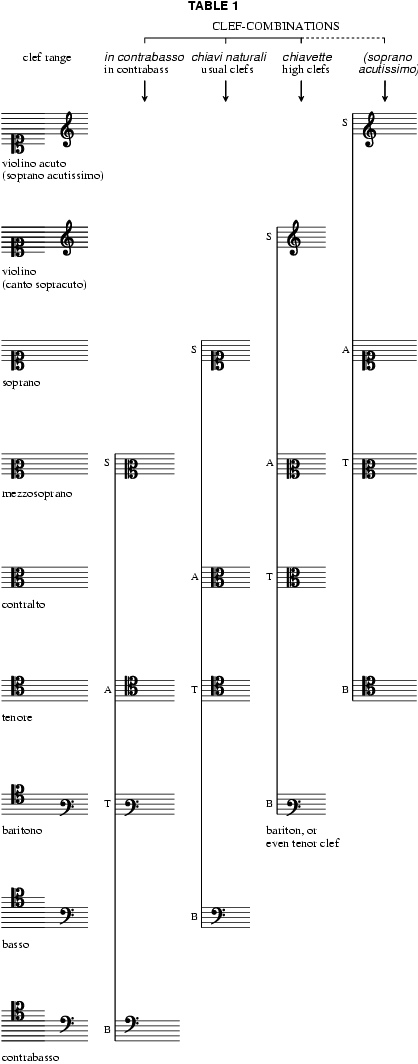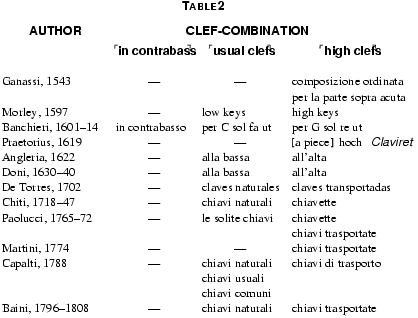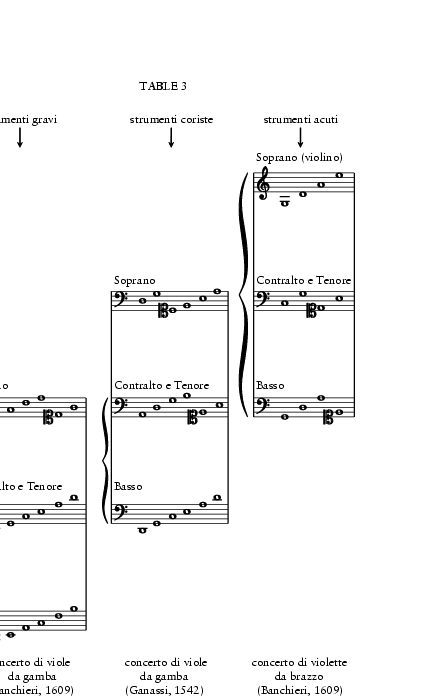
(It.: ‘little clefs’).
Term for certain combinations of clefs used in 16th- and 17th-century polyphonic music, distinct from the chiavi naturali (the combination of soprano, alto, tenor and bass clefs); it is especially used for the combination of ‘high clefs’ (treble, mezzo-soprano, alto and baritone clefs). Some theorists stated that the chiavette implied transposition by a 4th or 5th into the register of the ‘normal’ clefs, whence the alternative term chiavi trasportate (transposing clefs). These terms arose in the 18th century, when the practice was no longer current outside the papal chapel in Rome. Some modern scholars see clef combinations as an important clue to the mode of particular compositions, especially ones from late 16th-century Italy.
To correspond with Clef, italic letters are used here to represent the pitches as named by Guido of Arezzo (see Pitch nomenclature); a figure after the letter-name of a clef denotes the staff line on which it stands, counting from the lowest (e.g. the modern treble clef, g2, the modern bass clef, F4).

Table 1 provides an overview of the clef groupings. The first three were employed by composers while the fourth, soprano acutissimo, was added by Bononcini (Musico prattico, 1673) to complete the list of theoretical possibilities. In contrabasso notation was widely used by Franco-Flemish composers, but in Italy it appeared only in the polychoral compositions of the two Gabrielis and their followers; otherwise it had disappeared by the middle of the 16th century. Contrary to long-held opinion, in contrabasso notation was seldom employed to emphasize a funerary character: while there is a Josquin De profundisset in contrabasso, one by Willaert is notated in high clefs and Vatican sources provide several examples of non-funerary music in contrabasso, including Févin’s motet Le vilain jaloux and an Ave Maria by Marbrianus de Orto. High clef notation was used for much longer: in the age of Palestrina and Victoria the vast majority of a cappella polyphony was notated in this clef grouping. It remained in use in the stile diatonico osservato alla Palestrina of the Roman school throughout the 18th century and into the 19th, when it was last used by Giuseppe Baini (Apparuit Dominus Salomoni, 1837). This conservative practice was, however, restricted to composers writing for the papal chapel.
The first writer to mention standard and high clefs was Ganassi (Lettione seconda, 1543); he referred to the high clef grouping as ‘composizione ordinata per la parte sopra acuta’ (i.e. in the g2 clef). The term ‘chiavette’ first appeared in Girolamo Chiti’s Recercari, e solfeggi a voce sola di diverse chiavi of 1718 (ms, I-Rli Ms.Mus. P.15, p.11), by which time, however, these clef groupings had become obsolete everywhere except Rome. Chiti defined Chiavi naturali, or chiavi madri, as the seven clefs of the setticlavio musicale (g2, c1, c2, c3, c4, F3, F4) with at most one flat in the key signature. Chiavi accidentali, or ‘chiavette’, were the same seven clefs but brought into use for transposition by the addition of a key signature of sharps or of more than one flat. The chiavette (‘baby clefs’) were thus seen as generated from the chiavi madri (‘mother clefs’) to facilitate transposition – thus the term ‘transposition clefs’ used by 18th-century theorists. Some writers (Paolucci, 1765–72; Becherini, 1813) used the term ‘chiavette’ for those clefs other than F4 used for a few bars here and there in a figured bass part to avoid ledger lines. Table 2 lists the names by which the different clef combinations have been designated.

The origin of the chiavette clef groupings is a source of controversy. It is clear, however, that the need to notate the ambitus of each of the eight (later 12) modes without resorting to ledger lines played a role (see Bononcini). This led to a difference in character between a mode as notated in the normal clefs (i.e. chiavi naturali) and as notated in high clefs: each ambitus has a different interval structure, and there was a different relationship between the highest note and the finalis (see Kurtzman, who confirmed an earlier observation by Hermelink). Another factor was the convention (see Paolucci and Martini) of conforming to the original key of a cantus firmus as it had appeared in the antiphonary; once the appropriate transposed clef was chosen for the tenor, the notational system had to be adjusted to keep the parts at the correct distance from each other. Kurtzman analysed the relationship in Rome between the notation of plainchant antiphons and that of the polyphonic psalms and Magnificats with which they were modally associated in the Office; he found confirmation of the importance of this factor and suggested that this notational correspondence could be the origin of high clefs.
Chiavette clearly played an important role in the modal system. Towards the end of the 16th century, the confusion among eight ‘psalm-modes’, the eight ‘motet-modes’ and the 12 new Glarean modes made correct identification even more difficult (Powers). Bona (1595) and Cerone (1613) affirmed that transposition clefs could be of help in this task. The Spaniard Joseph de Torres y Martinez Bravo (1702), however, declared that the type of notation, together with the finalis, was sufficient for identifying the mode. The custom of using the final note of the bass to identify the mode had already been mentioned by Galilei (Fronimo, 1584); in 1640, Doni (Annotazioni sopra il compendio) explicitly confirmed that in order to differentiate between the authentic mode and its plagal, in the latter case the above mentioned final note was an octave lower than in the former. The disappearance of chiavette in the mid-17th century may have been directly linked to the growth in popularity around that time of the modern tonal system, in which the ambitus is not a defining element. But the decline of the system might also have been caused by the increasing use in the late 16th century of instruments such as the violin and the cornett, which were capable of producing higher pitches than all but a few singers; the larger range of these instruments hastened the abandonment of chiavette for voices.
Only
those pieces set in chiavi naturali were considered unproblematic for
standard vocal ensembles. Pieces notated in high clefs were intended to be
transposed downwards, according to Ganassi, by a 5th, and according to
Banchieri (Cartella, overo Regole, 1601) and Picerli (Specchio
secondo di musica, 1631) by a 4th when the B![]() is present in the signature and by a 5th
with no key signature. An explanation of Banchieri’s rule is the following
(Baini, 1828). When the mode is notated in high clefs and there is a flat in
the key signature, this means that the piece has been transposed a 4th upwards;
for the piece to be sung, it must be returned to its natural place by removing
the flat and lowering it by a 4th. When, however, the mode is set in high clefs
but without a flat in the key signature, it has been transposed to remove the
flat; for it to be sung, it must therefore be returned to its proper transposed
key by restoring the flat and lowering it a 5th. The converse applies to pieces
notated in contrabasso.
is present in the signature and by a 5th
with no key signature. An explanation of Banchieri’s rule is the following
(Baini, 1828). When the mode is notated in high clefs and there is a flat in
the key signature, this means that the piece has been transposed a 4th upwards;
for the piece to be sung, it must be returned to its natural place by removing
the flat and lowering it by a 4th. When, however, the mode is set in high clefs
but without a flat in the key signature, it has been transposed to remove the
flat; for it to be sung, it must therefore be returned to its proper transposed
key by restoring the flat and lowering it a 5th. The converse applies to pieces
notated in contrabasso.
The above rule finds agreement in Italian sources dating from about 1561–3 to 1608. In mid-17th century Rome only transpositions to the 4th below are mentioned, and at the end of the century and throughout the next the transposition was to a 3rd below on account of the lowering by a whole tone of the pitch of Roman organs. Exceptions to the rule were provided by Philippe Rogier, whose first kyrie in the Missa ‘Domine Dominus noster’ (c1590–95) is the earliest example of a sacred composition in high clefs with a bass part for organ already transposed, Morley, who in 1597 declared against any kind of transposition, Praetorius (Syntagma musicum, iii, 2/1619) and Schütz (1619–36). According to J.B. Samber (1707), the downward transposition should be by a 4th when the bass is notated in F3, by a 5th when the bass in notated in c4. In general, transposition seems to have been made to suit the singers.
‘Standard’ clef combinations came into use in the second quarter of the 16th century; from that time onwards it was possible to speak of variants. Hybrid clef combinations such as c1, c3, c4, F3 required no transposition; in order to prevent the organist from transposing automatically on seeing the clef F3, the continuo part was marked ‘sonate come stà’ (play as it stands). A similar situation is encountered in the clef combination g2, c3, c4, F4, but in this case the warning was applied to the treble part (in the early 17th century, violin or cornett). This clef grouping became common around the beginning of the 17th century when violins and cornetts began to play the leading treble parts.
When used in instrumental music, ‘transposition’ clefs were meant to be read at pitch. Banchieri (Conclusioni, 1609 and Cartella musicale, 1614) connected the three standard clef combinations with three different types of ensembles: ‘high clefs’ were linked with ‘strumenti acuti’, the ‘usual clefs’ with ‘strumenti choristi’ or ‘voci humane’ and ‘in contrabass’ with ‘strumenti gravi’ (see Table 3).

This division corresponds to the polychoral practice of composers such as the Gabrielis, Giacobbi, Lodovico Viadana, Leone Leoni, Clinio and Banchieri himself. Giacobbi (Salmi concertati, 1609) used the terms ‘choro acuto’, ‘choro ordinario’ and ‘choro grave’, and Viadana (Salmi per cantare e concertare, 1612) called for ‘acuto’, ‘capella’ and ‘grave’ choirs. This sytem may have led to the development of the low G-tuned viol consort, whose origin has long been unexplained.
G. Paolucci: Arte pratica di contrappunto (Venice, 1765–72)
G.B. Martini: Esemplare ossia Saggio fondamentale pratico di contrappunto sopra il canto fermo, i (Bologna, 1774)
L. and G. Baini: Trattato delle fughe sul canto fermo (MS, c1796–1808, I-Rc 2602) [partially pubd in Barbieri: ‘Chiavette’]
G. Becherini: Cognizioni pratiche della musica (Prato, 1813)
G. Baini: Memorie storico-critiche della vita e delle opere di Giovanni Pierluigi da Palestrina, ii (Rome, 1828/R)
A. Mendel: ‘Pitch in the 16th and Early 17th Centuries’, MQ, xxxiv (1948), 28–45, 336–57, 575–93
H. Federhofer: ‘Zur Chiavetten-Frage’, Anzeiger der Österreichischen Akademia der Wissenschaften, phil. -hist. Klasse, lxxxix (1952), 140–52
S. Hermelink: ‘Zur Chiavettenfrage’, Musikwissenschaftlichen Kongress: Vienna 1956, 264–71
S. Hermelink: Dispositiones modorum (Tutzing, 1960)
S. Hermelink: ‘Ein neuer Beleg zum Ursprung der Chiavette’, Mf, xiv (1961), 44–54
H.K. Andrews: ‘Transposition of Byrd’s Vocal Polyphony’, ML, xliii (1962), 25–37
H. Federhofer: ‘Hohe und tiefe Schlüsselung im 16. Jahrhundert’, Festschrift Friedrich Blume, ed. A.A. Abert and U. Pfannkuch (Kassel, 1963), 104–11
D. Wulstan: ‘The Problem of Pitch in Sixteenth-Century English Vocal Polyphony’, PRMA, xciii (1966–7), 97–112
A. Mendel: ‘Pitch in Western Music since 1500: a Re-Examination’, AcM, l (1978), 1–93; pubd separately (Kassel, 1979)
H.S. Powers: ‘Tonal Types and Modal Categories in Renaissance Polyphony’, JAMS, xxxiv (1981), 428–70
H.S. Powers: ‘Modal Representation in Polyphonic Offertories’, Early Music History, ii (1982), 43–86
A. Smith: ‘Über Modus und Transposition um 1600’, Basler Jb für historische Musikpraxis, vi (1982), 9–43
A. Parrott: ‘Transposition in Monteverdi’s Vespers of 1610: an “Aberration” Defended’, EMc, xii (1984), 490–516
C. Monson: ‘Elena Malvezzi’s Keyboard Manuscript: a New Sixteenth-Century Source’, EMH, ix (1989), 73–128
P. Barbieri: ‘ Chiavette and Modal Transposition in Italian Practice (c1500–1837)’, Recercare, iii (1991), 5–79
P. Barbieri: ‘Corista, chiavette e intonazione nella prassi romana e veneto-bolognese del tardo Rinascimento’, Ruggiero Giovannelli: Palestrina and Velletri 1992, 433–57
S. Bonta: ‘The Use of Instruments in the Ensemble Canzona and Sonata in Italy, 1580–1650’, Recercare, iv (1992), 23–43
H.S. Powers: ‘Is Mode Real? Pietro Aron, the Octenary System, and Polyphony’, Basler Jb für historische Musikpraxis, xvi (1992), 9–52
F. Wiering: ‘The Waning of the Modal Ages: Polyphonic Modality in Italy, 1542–1619’, Ruggiero Giovannelli: Palestrina and Velletri 1992, 389–419
P. Barbieri: ‘On a Continuo Organ Part Attributed to Palestrina’, EMc, xxii (1994), 587–605
J.G. Kurtzman: ‘Tones, Modes, Clefs and Pitch in Roman Cyclic Magnificats of the 16th Century’, EMc, xxii (1994), 641–64
PATRIZIO BARBIERI